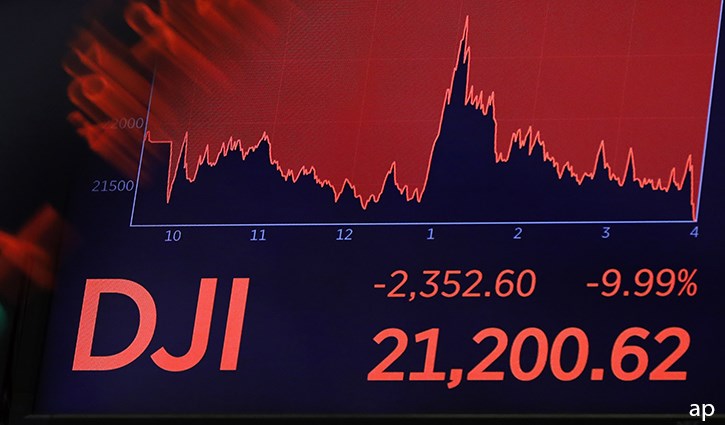
Plunging stock markets have sent many investors, professional and amateur, running for cover. But those brave enough to continue trading in these volatile market conditions can take some simple steps to protect themselves.
Here we run down the basic options for investors who are buying or selling at the moment:
Don't Just Choose the Default
When you trade “exchange-traded instruments” – shares, investment trusts and ETFs – through an online broker, whether you want to buy or sell, you are offered the choice of “Market order” or “Limit order”.
Many people would choose “Market order” because it’s simpler and is usually the default choice. With this option, you are given a quote based on the current price the investment is trading at and a breakdown of charges. Typically, you are given only a short time (around 10 seconds) to accept the price or not before it updates.“Investors tend to use market orders in instances where time is of the essence and price is of secondary importance,” says Ben Johnson, Morningstar’s director of global ETF research.
If the market is closed and a price isn’t available, orders are executed “at best”, ie. your investment platform will try to get the best price. In highly volatile markets, this can be risky in the extreme – especially with many markets plunging at the open.
If you advise your broker to trade "at best" you are are likely thinking that you will get something close to the closing price. But if the market plunges as it opens, the best price that the broker can achieve can be much lower than you expect. If there is a wave of sell orders at the open, a buy price is often difficult to achieve.
Should you Use a Limit Order?
A limit order introduces an element of control over the price you pay for an investment. These allow you to set the maximum price you want to buy at or the minimum price you want to sell at. If the price is met the trade goes through, if not the trade expires at the next market close.
Limit orders are free and easy to set up. Deciding on the price is the harder part; in volatile markets it makes sense to build a bit of a buffer for market moves up and down. Market experts suggest that around 20% either side of the current price is a a sensible yardstick.
In falling markets you are protecting yourself by saying effectively - "I won't sell share x for less than x", which is useful if the price plummets.
In rising markets, you won’t pay more than the price you specify if the share soars. While this may seem a remote scenario at the moment, as our research shows, market falls are often followed by very strong rebounds.
“Limit orders will ensure favourable execution from a price perspective,” says Johnson. But the trade-off is that you often have to wait longer to get the price you want.
Stop Losses Can Limit Falls
Open-ended funds are different because they are not “exchange traded”. Stocks, ETFs and investment trusts are listed on an exchange and therefore constantly priced while the market is open as investors buy and sell. But a fund is only priced once per day, often at midday but not always, and offers daily dealing, meaning orders can be placed any time but will not be executed until the next pricing point.
That brings with it risks to buyers and sellers; you might decide to sell or buy on one day but the price may have moved lower (or higher) by the time the deal goes through.
“Stop losses” are familiar to those trading derivatives like contracts for difference – in simple terms, these provide a buffer that stops you losing significant chunks of your capital.
“Using a stop loss is a great first step in taking the psychological element out of your trading, by automatically closing a losing position that you might have otherwise let run,” IG says.
Some investment platforms offer stop losses to their retail customers for shares and other traded securities: you can specify the price to sell at if the shares hit a certain level, and specify how long you want to keep this in place (up to 90 days usually).
100% Loss But Unlimited Upside
Stop losses cost more money than trading without protection: a typical broker would charge 0.15% for trading a UK share and an additional 0.25% for adding a stop loss.
But even in bull market conditions, a profit warning can knock 30-40% off a company's share price in a single day, so this added insurance can protect against severe loss of capital. As an investor in shares, you always face the prospect of losing 100% of your capital with every investment. Companies go bust all the time and ordinary shareholders are bottom of the pile when that happens.
IG says deciding where to put a stop loss takes skill: "Place it too far away from the current share price, and you could be risking too much on each trade. But place it too close, and your position could get automatically closed due to short-term price fluctuations, incurring a loss on a market that’s actually destined to recover."
Taking a share of 100p as an example: if you set a stop loss of 80p, your position will be “closed out” automatically if the price falls to 80p. If it keeps on falling beyond that, you will be pleased that you're protected. Set a stop loss of 50p, however, and it hits that - then rebounds back to 80p - you've effectively guaranteed a 50% capital loss and missed the upside.
The flipside for the investor is that, while the risk to capital in share investing is 100%, the potential upside is unlimited.
How do you benefit from the upside while protecting your capital? A "stop limit", again at an extra premium for traders, is the reverse of the stop loss and can lock in some gains. In our 100p example, you set a "stop limit" at 130p - when the share hits that level, you've gained 30%, even if the share price moves back to 100p and lower.





























